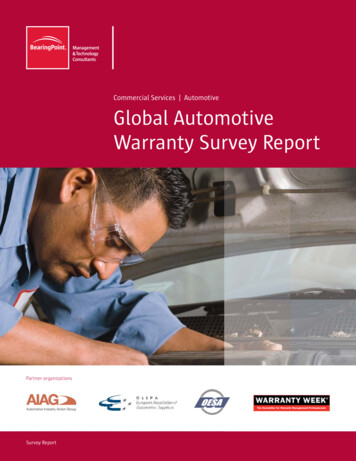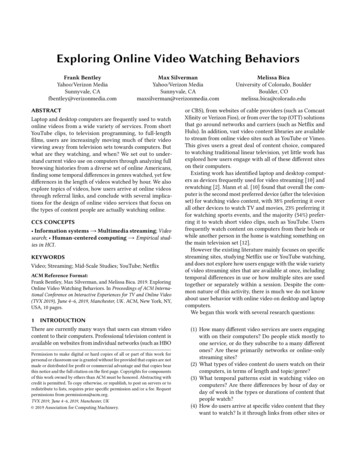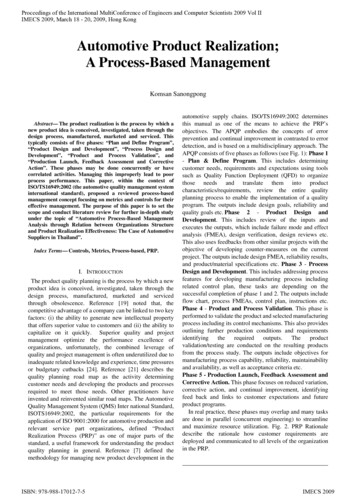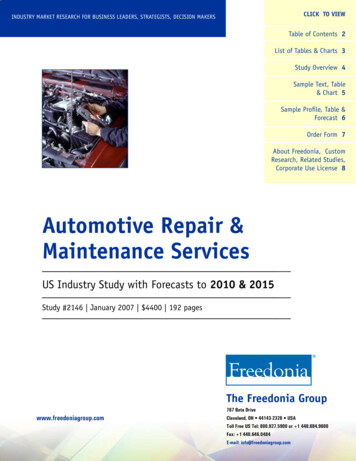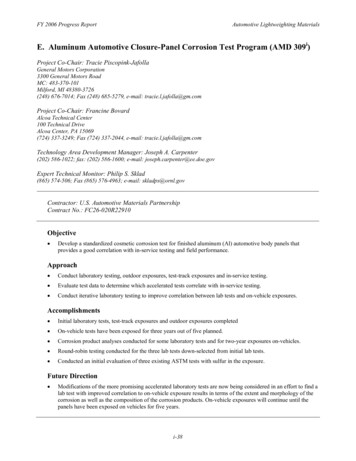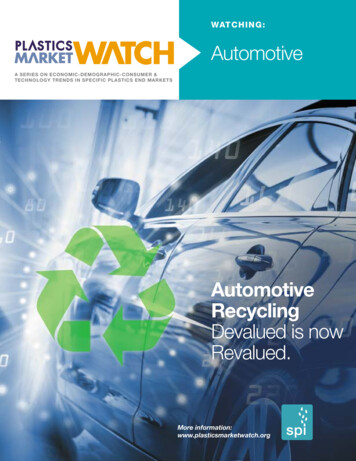
Transcription
WATC HING:AutomotiveA SERIES ON ECONOMIC-DEMOGRAPHIC-CONSUMER &TECHNOLOGY TRENDS IN SPECIFIC PLASTICS END MARKETSAutomotiveRecyclingDevalued is nowRevalued.More information:www.plasticsmarketwatch.org
2016 SPI: The Plastics Industry Trade Association.All rights reserved.1425 K Street, NW Suite 500 Washington, DC 20005-3686
AutomotiveRecycling:Devalued isnow Revalued.A SERIES ON ECONOMIC-DEMOGRAPHIC-CONSUMER &TECHNOLOGY TRENDS IN SPECIFIC PLASTICS END MARKETSCONTENTSClosing the loop on auto plastics:Growing opportunities for use ofrecycled content and recovery. 2Plastics Growing Role in Auto Manufacturing. 7Current Automotive Recycling—Vehicles and Parts. 17Recycled Plastics in Automobile Partsand Components. 23Research and Work Underway forPlastics Recycling in Automobiles. 33Conclusion. 40Sources. 42SPI: The Plastics IndustryTrade AssociationPLASTICS MARKET WATCH: DEVALUED IS NOW REVALUEDiii
Special thanks to members of the SPI RecyclingCommittee and the Transportation & Industrial PlasticsCommittee for their guidance and input on this Automotive Recycling Report.Materials compiled, written and edited by William (Bill)Mashek, with editorial assistance from Kim Holmes andKendra Martin, SPI.Plastics Market Watch (Report) is provided for general information purposes only.The information in the Report was obtained through voluntary sources believed tobe reliable, but the information is in no way guaranteed. The use of any of the information found within is at your own risk. No lawyer-client, advisory, fiduciary or otherrelationship is created between SPI: The Plastics Industry Trade Association (SPI) andany person accessing or otherwise using any of the information in this document. SPI(and any of their respective directors, officers, agents, contractors, interns, suppliersand employees) will not be liable for any damages, losses or causes of action of anynature arising from any use of this report. 2016 SPI: The Plastics Industry Trade Associationiv PLASTICS MARKET WATCH: DEVALUED IS NOW REVALUEDSPI: The Plastics IndustryTrade Association
AutomotiveRecycling:Devalued is nowRevaluedSPI: The Plastics IndustryTrade AssociationIntroductionPLASTICS MARKET WATCH: DEVALUED IS NOW REVALUED1
Closing the loop on auto plastics:Growing opportunities for use ofrecycled content and recoveryLast year, SPI initiated the Plastics Market Watch series to study the economic,demographic, consumer and technology trends in specific plastics end markets. SPIpublished four reports: Automotive & Transportation, Plastics in Healthcare & MedicalDevices, Plastics in Packaging, and Plastics in Building & Construction.The series provides our members—and the plastics industry at large—with forwardlooking reports that blend economic and demographic data to paint the landscapeplastics facing in key sectors.For the first issue of 2016—Automotive Recycling—we provide an extension andfurther analysis of the Automotive & Transportation report, while drilling down on a specificarea that many SPI members are involved in: recycling plastics, moving toward zero netwaste manufacturing and developing new plastic components with recycled content forthe automotive industry.With this report, we are expanding our intended audience to reach not only SPImembers, but also key partners and customers in the plastics life cycle, including automanufacturers and designers, scrap recyclers, and policymakers. A look at automotiveIt is critical thatstakeholders outsidethe plastics industryrecognize the value ofthe material not onlyin the automotivemanufacturing process,but also in terms ofpost-industrial andpost-consumer recycledmaterial that can beused in products, bothin auto applications aswell as other industries.recycling and the design of new partsusing polymers and recycled plasticsrequires a broader analysis and audience.It is critical that stakeholders outside theplastics industry recognize the value ofthe material not only in the automotivemanufacturing process, but also in termsof post-industrial and post-consumerrecycled material that can be used inproducts, both in auto applications as wellas other industries.2 PLASTICS MARKET WATCH: DEVALUED IS NOW REVALUEDSPI: The Plastics IndustryTrade Association
Auto recyclers have been focusing on the recyclability of some car parts and components for decades, most notably steel parts. In contrast, automotive plastics recycling isPlastics makestill in its relative infancy, given the fact that recycling some plastic and polymer compositeup aboutproperties of plastics.components can be challenging in terms of costs, technologies required and the very50%Significant strides are being made to recycle plastics, however, particularly post-industrial scrap, and use recycled plastic materials in car parts as automotive companieshave made strong commitments to reduce waste and incorporate recycled materials innew vehicles. The quality of recycled bales and materials have dramatically improvedover the past few decades, increasing the ability of engineers to use recycled plastic forof a modernautomobile’s volume,but only10%of its weight.new components.As part of our mission of pursuing zero waste, SPI works to leverage the strength ofour full supply chain membership—from resin suppliers and equipment manufacturers toprocessors, brand owners and recyclers—by identifying challenges to recycling acrossthe variety of plastic packaging and products. In the transportation end markets, likeautomobiles, SPI is undertaking projects to help identify opportunities for both recyclinguseful plastic from automobiles that have reached the end of their practical life, as well asusing recycled content to build new cars and components.Plastics and recycled plastics are playing an innovative and growing role in automotive manufacturing around the world. The Plastics Division of the American ChemistryCouncil reports plastics make up about 50 percent of a modern automobile’s volume,but only 10 percent of its weight. Engineers and designers looking for cost and weightsavings are embracing technologically advanced plastics components for their uniqueproperties and flexibility.The paramount catalyst for embracing plastics in car designs is meeting orexceeding the Corporate Average Fuel Economy (CAFE) standards and helping boosta vehicle’s fuel mileage. The amount of plastics in auto-CAFEmobiles is increasing, but with the auto industry’sfocus on reducing costs, and the recent significant drop in oil and natural gas prices,the market dynamics of using virginresins vs. recycled content materials isshifting. For this reason, it’s importantfor auto manufacturers to recognizethe value of recycled content, both interms of material properties as well asenvironmental benefits. The value ofrecycled content extends far beyondthe potential cost savings that can attimes be realized.Auto manufacturers recognizeCorporate Average Fuel Economy (CAFE) standardscultural trends and buying habits ofconsumers who want companiesand products to be environmentallyresponsible. Some U.S. and foreignmanufacturers have been at the forefront of the green movement, not onlySPI: The Plastics IndustryTrade AssociationPLASTICS MARKET WATCH: DEVALUED IS NOW REVALUED3
in terms of developing lighter, safer andAround the world, 27million cars reach thealternatively fueled vehicles, but also inreducing waste and recycling materialsincluding plastics.Plastics can be found inside andend of their useful livesoutside of every vehicle on the roadeach year—some areweight of automobiles by 500 to 750the average 11-year oldof plastics being used in automobiles,vehicles driven untilend-of-life—about 27 million every yearothers are currentyear models involvedin crashes.500 lbs.today. On average, plastics reduce thepounds. But with about 39 different typesrecycling those vehicles at their practicalaround the world—can be a challenge.their last mile whilePlastics reduce autoweight on average byHowever, with increased use of plasticsin vehicles, increased attention should begiven to what happens to those plastics39different types ofplastic used in autoswhen vehicles reach their end of life.Increased awareness and understanding of plastics and recycled plasticsin automotive manufacturing is alsoneeded with the very engineers thatare developing designs and specifications for new components. High-qualityrecycled plastics, at scale, need to be provided to automotive engineers at a competitive price. Cross-industry collaborations are critical for the continued development anduse of recycled plastics in automotive parts—and the recycling of plastics used duringautomotive manufacturing and end of life. The car-buying public, particularly youngerconsumers, are interested in the footprint of their vehicle and the companies that manu-27 millionELV autos everyyear worldwidefacture their products; plastics should be at the forefront of the conversation about futureautomobile production and recycling.SPI is releasing this paper as part of its 2016 Re focus—Recycling Summit & Expoin Orlando, Florida. “Key Trends in Auto” will be one of the industry tracks during thesummit. SPI will discuss this report and share it with other stakeholders including automotive manufacturers, materials suppliers, processors, recyclers, automotive recyclersand policymakers. We welcome your feedback on the report.4 PLASTICS MARKET WATCH: DEVALUED IS NOW REVALUEDSPI: The Plastics IndustryTrade Association
AutomotiveRecycling:Devalued is nowRevaluedSPI: The Plastics IndustryTrade AssociationPlasticsGrowingRole in AutoManufacturingPLASTICS MARKET WATCH: DEVALUED IS NOW REVALUED5
By 2020, IHS estimatesthe average car willincorporate about 770pounds of plastic byweight compared to the440 pounds averaged in2014—an increase of75 percent.6 PLASTICS MARKET WATCH: DEVALUED IS NOW REVALUEDSPI: The Plastics IndustryTrade Association
Plastics Growing Role in AutoManufacturingFrom SPI’s Market Watch report published last year, “Automotive & Transportation,”a number of factors, including economics, demographics and the need for lightweight,fuel-efficient vehicles, are boosting the plastics industry’s contributions to car, truck andtransportation design and manufacturing.Automobiles are a growing market for plastics as car sales increase. A number offorces combined in 2015 to spur an all-time record of U.S. car sales topping a 15-year-oldpeak. Cheaper gas prices, improved employment numbers and continued low interestrates helped automakers sell 17.5 million cars and light trucks—a 5.7 percent increasefrom 2014. Global automotive sales for 2015 jumped 2.4 percent to hit 88.6 millionvehicles, according to IHS Automotive—marking a fifth year of growth. IHS has indicated90 million vehicle sales worldwide will be within reach for 2016.With this growing number of vehicle sales, the embrace of plastics and new polymertechnologies by automotive and transportation engineers will continue in passengercars, trucks and mass transit vehicles.By 2020, IHS estimates the average carwill incorporate about 770 pounds ofplastic by weight compared to the 440pounds averaged in 2014—an increase of75 percent.More parts are being developedwith plastics as technology has improvedthe tensile strength and other propertiesof plastics when compared to traditional metals like steel and aluminum.The development of thermoplastics wasa watershed event in that it led to polyamide, polyacetal and polycarbonatethat allowed engineers to blend differentplastics to create new and useful engineering-grade materials.Already the third largest sector ofU.S. manufacturing in dollar value of shipments, plastics in the automotive industrywill continue to grow as new materials are utilized in designs. Carbon fiber reinforcedplastic (CFRP) usage in vehicles will increase from 3,400 tonnes in 2013 to 9,800 tonnesin 2030. The expectation of increased use of 3D printing and its derivatives will pave theway for even more innovative applications of plastic in and outside of cars, particularly forspecialty cars and specialization.SPI: The Plastics IndustryTrade AssociationPLASTICS MARKET WATCH: DEVALUED IS NOW REVALUED7
The quest for lightweighting vehicles has been ongoing for decades across everyFrise predicts the truly ground-manufacturer whether the new material be plastic, aluminum or carbon fiber. While thesebreaking innovations in automotive manu-initiatives may not have been the focus of advertising campaigns like Ford Motor Co.’sfacturing will become routine within a“military grade” aluminum featured in the 2015 F-150 truck, the company and others havematter of years as the entire automotivebeen driving innovation in manufacturing for building trucks and cars for years.supply chain adapts and innovates.Peter Frise, a mechanical engineer and the scientific director at AUTO21, an auto-Matthew Marks, chair of themotive research think-tank at the University of Windsor told CBC News that despiteAmerican Chemistry Council (ACC)the steel vs. aluminum marketing battle between some companies, lightweighting willPlastics Auto Division team, participatedcontinue. “They can’t just keep making the same stuff. They’ll have to adopt new tech-on a panel about lightweighting at thenologies, new design methods there will be big changes.” And these changes will likely2015 CAR Management Briefing Seminarsmean increased material replacement opportunities for plastics.and called for “a little” risk in research anddevelopment of new components. “Let’sThe world’s first 3D-printed car, the StratiEV, by Local Motors and Cincinnati Inc., ondisplay in SABIC Innovative Plastics boothat NPE 2015.It has been about 18 months since theA
mation found within is at your own risk. No lawyer-client, advisory, fiduciary or other relationship is created between SPI: The Plastics Industry Trade Association (SPI) and any person accessing or otherwise using any of the information in this document. SPI (and any of their respective directors, officers, agents, contractors, interns, suppliers and employees) will not be liable for any .

